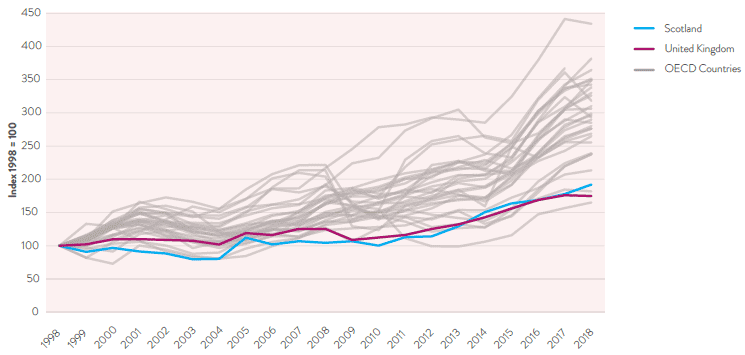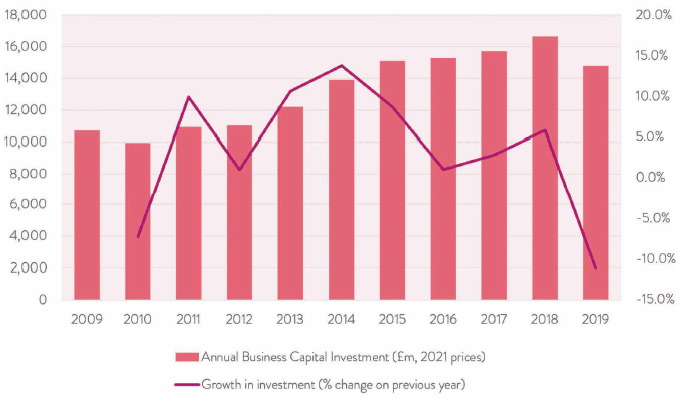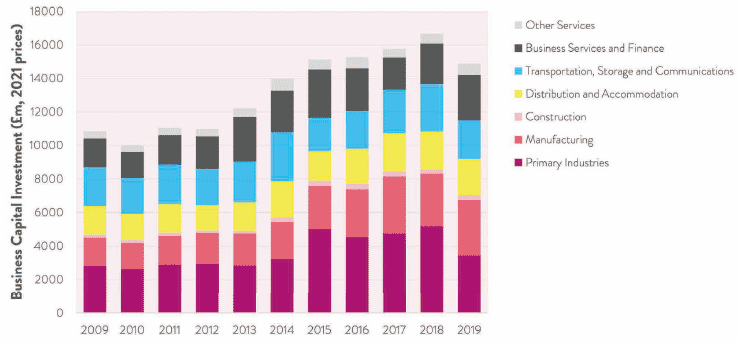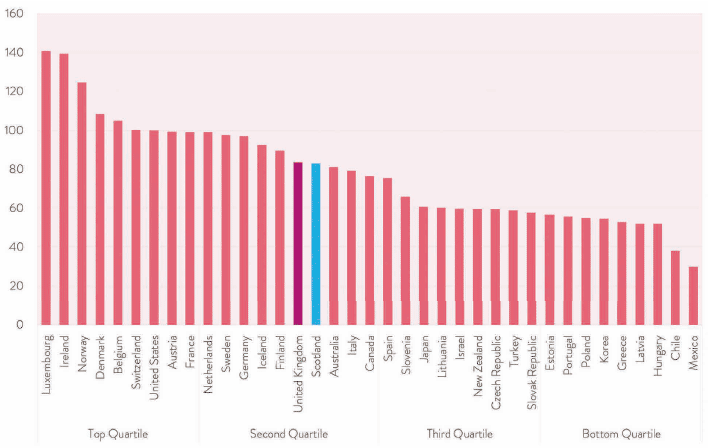Investing with Purpose: global capital investment plan
Plan articulating the important role private capital investment can play in driving an investment-led recovery. The plan focuses on sectors where Scotland can demonstrate a real international comparative advantage, and marks a pivot in our approach towards targeting ESG investment.
1. Why Capital Investment is Important
1.1 Why do we need a Global Capital Investment Plan?
Scotland's economy faces a number of challenges, both short and long-term. The economic impacts of the COVID-19 pandemic and of the UK's exit from the EU are yet to be fully seen, but are likely to be with us for some time. Scotland, along with the rest of the UK, has a long-acknowledged issue around under-investment and slow productivity growth. The imperatives of the transition to Net Zero are critical, and demographic shifts place greater demand on public resources while reducing the working age population. Change is both necessary and inevitable, and the need to 'build back better' is a challenge we share with other advanced economies.
Our strengths in skills, academic excellence, research and innovation, advanced technologies and natural resources give us the tools to do the job. However, to mobilise these assets, and build a wellbeing economy with fair work and inclusive growth at its heart, requires capital investment at levels significantly higher than at present.
The report from the Advisory Group on Economic Recovery, and the Scottish Government's response to it, highlight the need for an investment-led recovery to upgrade infrastructure and support business growth. It also recognises that while much of this capital investment will come from the public purse, the role of private sector investment is critical in achieving pace and scale – either directly into businesses and projects in Scotland, through partnership with public sector investment, or through public sector borrowing on capital markets.
1.2 What This Plan Seeks To Do
This Global Capital Investment Plan is the third of our three strategies setting out how we will enhance Scotland's position on the international stage as a dynamic, innovative nation with an outward facing economy. Following on from our Inward Investment Plan and Export Growth Plan, it sets out how we will attract productive forms of private capital investment, in sufficient volumes, focused on creating the market conditions for an investment-led recovery in a way that is consistent with our values. For the purposes of this analysis we consider private capital investment as being distinct from inward or foreign direct investment. Inward investment involves a company or institution headquartered outside of Scotland establishing or expanding operations within Scotland. Private capital investment, by contrast, involves debt or equity financing in a business, project, or development.
As important as what this plan is for, is what it is not for. We draw clear distinctions between those investments that are required to be undertaken solely by the public sector. This is not a plan to lever private investment into core public services but rather to increase the flow of private capital into areas where it is already present, or where the Scottish Government's vision for infrastructure, as set out in our Infrastructure Investment Plan, has identified that private capital can support Scotland's resilience and enable inclusive, Net Zero, and sustainable growth. And whilst markets which already function in Scotland, such as that for wind energy, are noted here, this is not a plan to intervene where there are already good and useful levels of market activity.
It is also not a plan to consider or enact how we work with banks to support all businesses out of post-crisis debt. That is covered in 'Financing the Recovery', and our work to ensure that crisis and recovery schemes contribute broadly to the recovery of Scotland's company base. It is a closely related agenda, but this plan is focused only on those companies and sectors for whom investment markets are a realistic and suitable route to growth and scaling.
Through segmentation and analysis of current capital flows, the plan sets out Scotland's best offer to capital markets. Our strategy for capital investment seeks to maximise the alignment between the investment needs we have in Scotland and the supply of internationally mobile capital, by raising the demand and viability of projects for investment, and by creating a strong enabling environment.
This plan outlines how the wider investment ecosystem in Scotland – including the mission driven approach of the Scottish National Investment Bank – align to support an economic recovery with fair work, inclusive growth and Net Zero emissions at its heart.
1.3 The Role and Impact of Capital Investment in the Economy
Investment is a key driver of economic growth. Along with consumption, government spending and net exports, it is one of the drivers of aggregate demand in an economy. Increasing investment (both public and private) should increase growth in the short-term, particularly in times of weak economic conditions, as is likely in a post-COVID-19 economy. In the long-term, the more significant role of investment is to boost growth through increasing productive capacity and productivity.
Scotland has seen the gap with overall UK investment close in recent years; however, the UK as a whole suffers from relatively low levels of investment. Business investment in Scotland is generally recognised to be a factor in economic underperformance and it can be seen clearly from Figure 1.1 that growth in this investment has been lower than in most OECD countries.

Source: Scotland (Quarterly National Accounts Scotland), UK (ONS), OECD countries (OECD). Note "business capital investment" based on national accounts measure gross fixed capital formation.
Figure description:
Figure illustrates growth over time of business capital investment, as measured by gross fixed capital formation, for Scotland, the UK and other OECD countries. The data is indexed to equal 100 in 1998 and shows growth between 1998 and 2018.
Recent levels and growth in business investment, as measured by the technical term, gross fixed capital formation in the Scottish Government Quarterly National Accounts, are shown in Figure 1.2. The average annual growth figure over the most recent ten years for which data is available is 3.3%. However, this is volatile from year to year – over this period in Scotland it has ranged from -11% to 14% in real terms – reflecting the influence of large investments, for example in renewable energy, which may land in some years but not others.

Source: Quarterly National Accounts Scotland (converted to 2021 prices)
Figure description:
Figure illustrates the level and growth rate of business investment, as measured by gross fixed capital formation, between 2009 and 2019.
Figure 1.3 shows Scotland's overall business investment split by sector. Overall business investment has been driven by growth in most sectors in recent years, with particular increases in primary industries, manufacturing, business services and accommodation/distribution. Production sectors (manufacturing and primary industries) accounted for a disproportionately large share of business investment in 2019 (45%) compared to their share of Scotland's overall gross value added (19%), reflecting the capital intensive nature of these sectors.[2] Services sectors accounted for 53% of business investment in 2019, compared to 75% of Scotland's overall gross value added.

Source: Quarterly National Accounts Scotland (converted to 2021 prices)
Figure description:
Figure illustrates the level of business investment, as measured by gross fixed capital formation, split by sector, between 2009 and 2019.
Definition – Business Capital Investment vs Private Capital Investment
It is important to distinguish between the two definitions of private or business capital investment. The economic definition focuses on investment in new long-term assets (such as new office buildings, wind farms or business machinery) which help produce more output in future and relates to the figures shown above. The financial definition centres around flows of funding into a business or project to help realise its goals (such as providing finance to an innovative business to help it grow). While there is a large degree of overlap, there are important differences between these definitions. In particular, some investment under the financial definition may not necessarily yield wider economic value, but rather represent changing ownership of existing assets. Our focus in this plan is on private capital investment which drives increased economic activity, rather than financial transactions (for example that relate solely to changes of asset ownership) that don't generate wider economic value.
To maximise the positive contribution of private capital investment to our wider economic goals, it is important to have a clear understanding of different types of financial investors, how they invest and the impacts of their investment activity – both directly and the wider spill-over benefits to society and our environment. This is particularly true if we are to support financial investment as a means to achieving wider economic impact and supporting recovery – bringing the financial definition to bear on the economic one. This is set out in the framework in Figure 1.4 and outlined in more detail in the following sections.
Figure 1.4: Framework setting out how capital investment impacts upon the economy
Investors
- Angel investors
- Venture capital
- Private equity
- Corporate
- Institutional Sovereign Wealth Funds
- Debt
What do investors do?
- Raise funds
- Invest in businesses/projects
- Provide expertise and management know how
Impact on business/project
- Business growth and employment
- Build/regenerate infrastructure and real estate
- Knowledge transfer between investor/investee
- Increase R&D
Impact on wider economy
- Firm spill-over impacts
- Project spill-over impacts
- Increase the capital stock
- Higher wages and/or employment
Impact on inclusive growth and wellbeing Productivity and growth Innovation Wellbeing (e.g. net zero, regeneration, health innovation)
1.3.1 The impact of capital investment on businesses and projects
Private capital investment promotes the creation of new businesses and helps businesses to realise their growth ambitions by removing a key barrier to expansion. Investors who bring market experience or industry knowledge can have a positive impact on the operating performance of investee companies and projects in terms of profitability and growth. Investing in research and development for new products and processes boosts innovation, as does supporting start-ups and early stage companies. Investment in companies to implement restructuring measures can enhance their productivity and thus help them to survive. Government may have a role here in specific cases, but the vast majority of private sector business investment does, and always will, come from private investors.
High quality infrastructure and quality of place are essential for businesses to operate efficiently, increase productivity and attract talent. Infrastructure and real estate projects also create economic activity through project construction and ongoing asset management. Investment may restore and regenerate unproductive assets, such as derelict buildings, for a new purpose, providing wider benefits to communities.
1.3.2 The impact of capital investment on the wider economy
Capital investment can have spill-over benefits on the wider economy, that are enjoyed by unrelated third parties to the investee business or project. For instance, a business growing, becoming more entrepreneurial or innovative has demonstration effects on other firms in the sector that can use the blueprint to improve their activities. There can be 'competition' effects where one business' growth leads other businesses to become more competitive and productive over time. Estimates by Oxford Economics in 2015 found that firms with angel and venture investment backing contributed around £30 billion to UK GDP, with around half accounted for by "indirect" channels such as supply chain impacts.[3] The Scottish Government's modelling for delivering our National Infrastructure Mission also reveals strong evidence of the link between infrastructure spending and improved economic growth. An investment-led stimulus has both a short-term demand effect but also a longer term supply effect by increasing the long-term productive capacity of the economy, enhancing productivity and wages and/or employment.
1.3.3 The impact of capital investment on productivity
Productivity performance is the most important determinant over time of growth in living standards. As Paul Krugman set out in his famous quote, "Productivity isn't everything, but in the long run it is almost everything. A country's ability to improve its standard of living over time depends almost entirely on its ability to raise its output per worker".[4] Analysis of productivity drivers show that while Scotland performs well in relative terms with respect to inputs such as skills, there is a case to be made that lower levels of capital investment – in businesses and infrastructure – is one of the reasons why Scotland, and the UK, lag behind other economies in terms of productivity growth.
Scotland currently ranks in the 2nd quartile of OECD nations for GDP per hour worked, a key indicator of productivity (Figure 1.4). Scotland's productivity growth, while higher than that of the UK in recent years, lags behind international competitors. In nearly every OECD country where productivity is above the Scottish level, annual average wages are also higher. On average for every 1% increase in productivity, annual wages increase by around 0.8% across OECD countries. If Scotland's productivity matched that of the OECD top quartile, annual wages could be almost £3,850 or 10% higher.[5]

Source: Scottish Government
Figure description:
Figure compares productivity levels as measured by Gross Domestic Product (GDP) per hour worked for Scotland and OECD nations. All countries are measured relative to the United States (which equals 100) and grouped into four quartiles depending on performance.
1.3.4 The impact of capital investment on wellbeing
Investment can create high quality jobs, which supports our inclusive growth ambitions and improves wellbeing. Private investment in innovative businesses and infrastructure can have an impact on wider social goals by, for example, improving digital connectivity and supporting health innovation. Increasing, directing and sustaining investment in the low carbon economy now will accelerate the transition to Net Zero. Not only will this reduce the impacts of climate change, it will also serve to create new industries, and improve air quality and health outcomes. The spill-over impacts may deliver greater wellbeing or community impact. Figure 1.5 demonstrates the wider economic and social benefits from private capital investment.
Figure 1.6: Global Capital Investment Plan
Policy
- Global Capital Investment Plan
Productivity
- Increasing investment
- Diffusion of innovation
- Improve infrastructure
Wellbeing
- Transition to Net Zero
- Investing in regeneration
- Improving health
1.4 A Growing Need for Investment
Increasing private capital in an economy can be highly beneficial, and can bring with it a series of other impacts. The inverse though can also be true. Persistent low levels of investment mean foregoing not just the direct funding impact, but also the availability of know-how and expertise; and demonstration effects from successful companies and projects.
Turning to recovery from a comparatively low level of investment is a challenge, particularly in simultaneously redirecting investment into new and developing areas, but it is also undeniably a big opportunity. Recent Scottish Government plans demonstrate a real strategic coherence around our investment opportunities that we can build on.
The Climate Change Plan updated in December 2020,[6] sets out the Scottish Government's policies that put Scotland on a pathway to achieving the ambitious annual climate change targets to 2032, established in law in Scotland, and, ultimately, to achieving Net Zero climate emissions by 2045. It provides a comprehensive route-map for decarbonisation across the Scottish economy and across the major sources of climate change emissions in Scotland. In doing so, the plan provides clear guidance over future government policy, regulations, and the path of public investment, enabling investment to take place in the low carbon economy confidently, with clear direction about where and how low-carbon markets in Scotland will grow.
The Infrastructure Investment Plan delivers the National Infrastructure Mission, with £33 billion of Scottish Government investment over the course of the next Parliamentary term. It also sets a long-term vision of infrastructure supporting an inclusive, Net Zero carbon economy in Scotland.
The Housing to 2040 Strategy will set out how we will deliver good quality, energy efficient, Net Zero carbon housing with access to outdoor space, transport links, digital connectivity and community services.
Our Inward Investment Plan identified Scotland's best global opportunities for securing inward investment across nine opportunity areas. While focusing primarily on creating or expanding operations, it will in itself create demand for capital investment.
These plans will also all be closely linked with a long-term spatial strategy for Scotland, to be set out in the National Planning Framework 4.
Each of those plans acknowledges and sets out the role of private sector investment as distinct from public sector investment. The Infrastructure Investment Plan is clear about the assets we want government to build and maintain, but also identifies needs for private sector investment, for example around digital and emerging technologies in the energy sector. Housing is already largely delivered by the private sector, with the primary role for the public sector around social housing or social rental accommodation. The Climate Change plan requires such a pace and scale of change that it is openly acknowledged that the private sector will take a role in funding and delivering new infrastructure, energy efficiency measures and power generation.
We have already demonstrated in the Inward Investment Plan that Scotland has global-level strengths in particular sectors and sub-sectors. Financing the Recovery now points to the need to help businesses transition out of debt and into growth finance to aid recovery. We will show later in this plan that the same sectoral lens as in the Inward Investment Plan can also be applied to private capital, and indeed that it can help support the transitions needed around infrastructure and climate change.
1.5 Illustrating the Impacts of Increasing Global Capital investment
The Global Capital Investment Plan covers a broad range of different forms of investment, including investment into business through equity, infrastructure and real estate. Robust evidence on the economic impacts of government action in these different areas is varied and often not available. Combined with the on-going economic uncertainty caused by the pandemic and EU exit, this makes it difficult to provide an estimate of the benefits to the economy of implementing the Global Capital Investment Plan.
However Scottish Government internal analysis[7] shows that the direct impact of increasing private sector business investment by 30%, to match the overall level among OECD countries (as a percentage of GDP), would increase the level of GDP by around 1.1% by 2030 (£1.8 billion per year). In addition to these direct impacts, an increase in investment would also be expected to have a productivity benefit for the Scottish economy, though we do not have evidence of the exact relationship between the two. Assuming the 30% increase in investment also increased the level of productivity in the Scottish economy by an illustrative 2%, then this would increase the GDP impact of investment to around 1.9% by 2030 (around £3.1 billion a year in 2019 prices). This could also increase average earnings in Scotland by 4.9%, around an additional £1,400 a year to the average Scottish employee. Increasing investment as set out in this plan will also support wider outcomes relating to Scotland's Net Zero and wellbeing economy ambitions.
More information on the modelling and the assumptions used can be found in the Analytical Methodology Note.
1.6 A Mission-Led Approach: Using our Values to Guide Private Investment in the Economy
Capital investment does not always lead to wider positive economic, social and environmental benefits. It is equally possible for it to extract value from the economy, to privatise gains and socialise costs, and to increase inequality. Governments face a real choice in what kinds of investment to support and welcome.
Societies stand and fall on equality and wellbeing as much as they do on economic growth. In our work as part of the Wellbeing Economy Governments we recognise the ways in which inequality negatively impacts our economy as well as society, by limiting human resources, inventiveness and productivity, and increasing the cost of public interventions in health, education, housing and justice. Inclusive growth is stabilising for the economy, and for democratic, open societies.
Alongside this, we must consider the urgent challenge of transitioning the Scottish economy to Net Zero carbon emissions by 2045. Ending Scotland's contribution is both an opportunity and a moral imperative, and must also form part of a Just Transition.
The 21st century is being increasingly defined by the need to respond to major social, environmental, and economic challenges.[8] These challenges do not have straightforward, single solutions; instead they are "complex, systemic, interconnected and urgent".[9] Our approach to harnessing private capital in support of our inclusive growth ambitions means that we are seeking to work with investors who share our aim to address the 'grand challenges' that we face in Scotland and internationally, and to do so in a way which is fair and which distributes benefits.
The Scottish National Investment Bank, the UK's first mission-led development bank, focusing on Net Zero, Place and People missions, begins to build the institutional architecture that will stand Scotland in good stead for the future. A similar mission-based approach is being used in the Infrastructure Investment Plan and the National Planning Framework.
The Global Capital Investment Plan supports this mission based approach to attracting the right kind of capital for the economic impact we want. Our Vision for Trade sets out how our trade principles underpin the trading and investment relationships we want Scotland to have now and in the future. These principles guide the implementation of our three cornerstone international economy plans on exports, inward investment and now on global private capital.
Contact
Email: investmentfinance@gov.scot
There is a problem
Thanks for your feedback